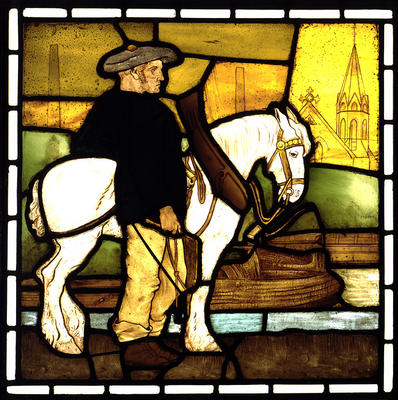
Canal Boatmen by Stephen Adam, c 1878, one of twenty stained glass windows made for Maryhill Burgh Halls depicting local trades and professions. The boatman is shown with his horse on a canal towpath, hauling a barge. There are barges on the far side of the canal and Maryhill High Church (originally Maryhill Free Church, built 1846-1848) and two industrial chimneys are shown in the distance.
The completion of the Forth and Clyde Canal from Stockingfield to Bowling in the 1780s encouraged the growth of Maryhill as an industrial village. Small clusters of housing sprang up alongside the sawmills, boatyards, ironworks and other industries that were established along the route. Thick-set aqueducts built across local roads, the imposing Kelvin Aqueduct, the Maryhill Locks and basins and the nearby Firhill timber basin, are among the canal's most impressive features.
Reference: 621.86.35
Reproduced with the permission of Glasgow City Council, Glasgow Museums
Keywords:
canal barges, canal boatmen, canals, Forth and Clyde Canal, horses, Maryhill Burgh Halls, Maryhill Free Church, Maryhill High Church, stained glass windows
You have 0 images in your photo album.